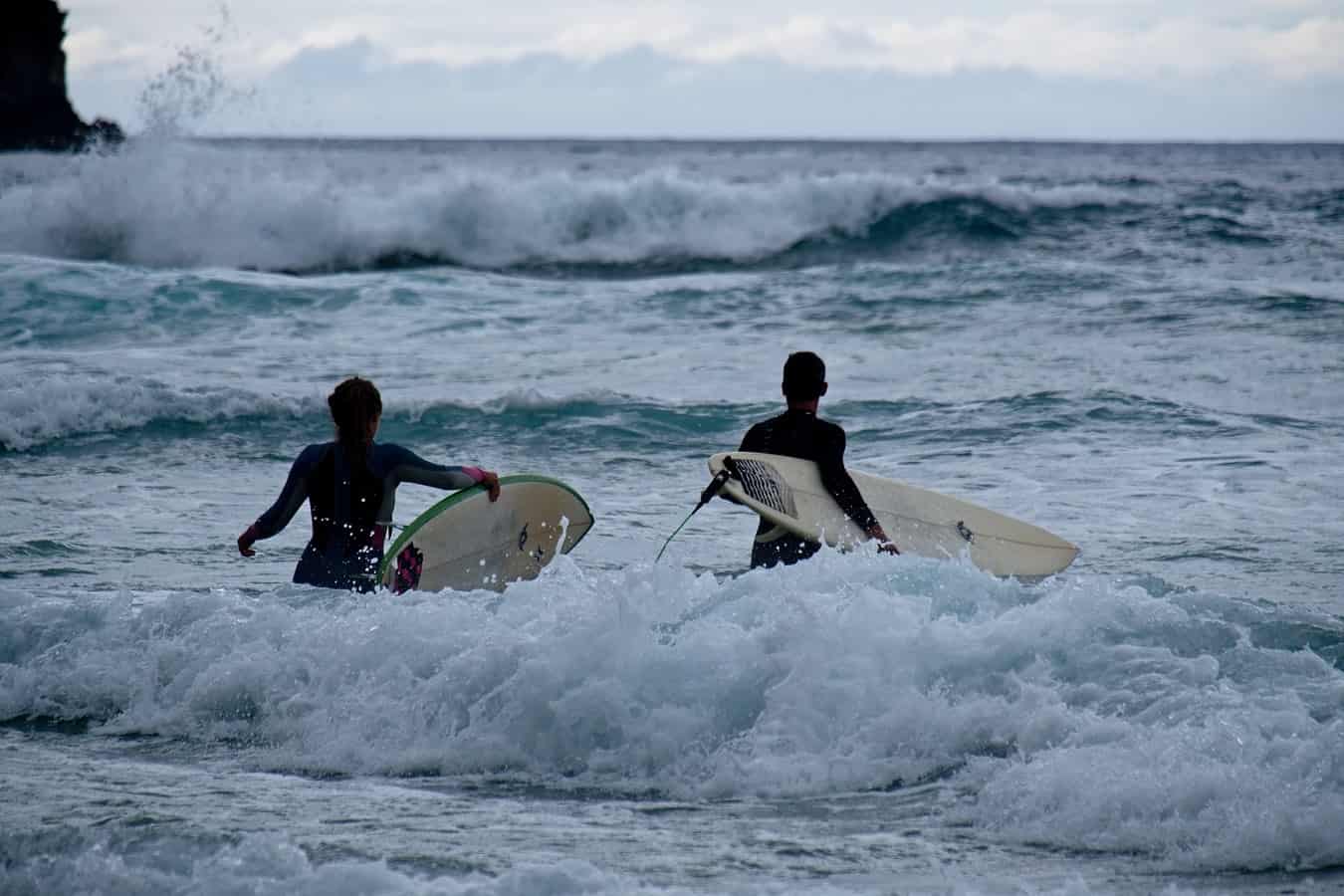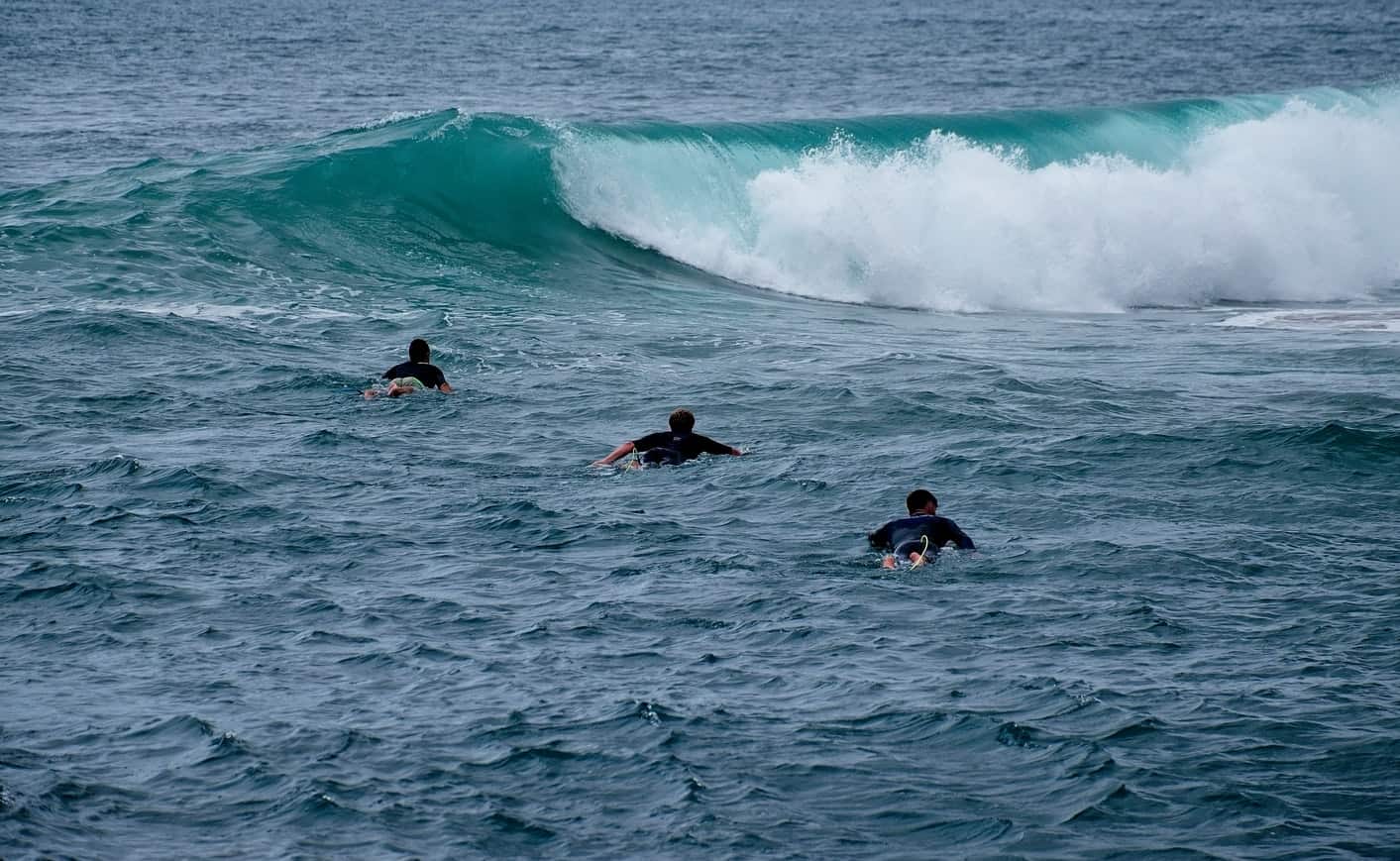If you’ve surfed for a good amount of time, or are just really getting into the swing of things as a surfer, you’ve probably heard of the term priority. Priority is an important part of surfer etiquette and safety.
So what does priority mean in surfing? Priority refers to when a surfer has the unconditional right of way to catch any wave they choose. Other surfers can paddle for and catch the same wave, but only if they don’t obstruct the surfer with priority.
How Does Priority In Surfing Work?
The concept of priority essentially determines the right of way for surfing. When a surfer has priority he or she has the unconditional right to catch any wave they choose. Priority is determined by many things, including which surfer is closest to the peak of the wave, which surfer has been waiting a spot longer and who paddles into the wave first. While many of these rules are based are enforced based on general etiquette, they also exist to keep surfers safe.
How Does Priority Work In Competitions?
In competitions, other surfers in the heat can paddle for, and catch, the same wave, but only if they don’t obstruct or hinder the scoring potential of the surfer with priority. At the start of the heat once the first wave has been ridden, the remaining surfer in the lineup gets automatic priority. A surfer loses priority once they catch a wave and/or their hands leave the rails as they attempt to stand up. If two or more surfers catch a wave, the first surfer to make it back to the lineup will get priority.
Is Priority Relevant Outside Of Competitions?
Yes, in fact the concept of priority is perhaps more important and day to day surfing than it is in competitions, where judges unbiasedly enforce the rules of priority. When there are no judges and it’s just you and your fellow surfer out on the water, it’s especially important to know the rules of the road for others safety, your own safety and to simply coexist respectfully with your fellow surfers.

How Do You Determine The Right Surf Spot?
There’s a saying in surfing: “If in doubt, don’t paddle out”. Surfing can easily be one of the most enjoyable experiences of your life, but like any sport, you need to stay honest with yourself and your ability. Because surfing is practiced in the ocean, it can get quite dangerous if you are out in the water in surfing conditions you aren’t comfortable with. Don’t ride waves you can’t handle yet.
This is why you need to choose the proper surfing spots for your level. Some spots have hollow, powerful waves, while other spots offer smaller, softer waves. The type of waves depends on both the surf spot itself, and the specific daily surfing conditions.
What’s Dropping In And Why Should I Avoid It?
When you surf, there will likely be other surfers out at your spot, wanting to catch the same waves as you. When this happens remember, “The Surfer Closest to the Peak has the Right of Way,” The general rule is that the surfer who has the longest potential ride has priority for the wave. This means the closest surfer to the peak (aka the breaking part of a wave) has the right of way, since he is the one who will enjoy surfing the wave’s shoulder for the longest ride. If you disobey this rule, you may risk dropping in on someone who was also planning to ride the wave, which is not only frowned upon but an enormous safety risk.
How Can I Avoid Dropping In On Someone?
You will most probably drop in on other surfers by accident at least a few times in your life. This happens to everyone. To avoid this, do the following.
Look to the peak. As you paddle for a wave, always take a look at the peak to see if someone else is paddling for your wave and has the right of way. Remember to always check the opposite direction you want to go to before you chase a wave.
Get off the wave. Once you actually are on your feet and realize you have dropped on someone, it’s not too late to fix your mistake. You can probably just go over the shoulder and off back the wave, potentially not even disturbing the surfer with priority. The surfer as well as other surfers checking out the waves will appreciate your correction and dedication to etiquette and safety.
What Is “The Line” And Why Is Taking Turns Is So Important?
Spots with consistent takeoff zones, such as reef breaks and point breaks, offer the possibility of having every surfer taking turns. Taking turns means that surfers wait “in line”, and let each other take a wave, one after the other. The one who has been waiting the longest will sit at the end of the line, closer to the peak, and will be the next one to paddle for a wave.. The surfer paddling back from a wave respectfully sits at the end of the line up and will be the last one of the group to get a wave.
Spots like beach breaks have many take off zones. Each zone can have its own individual line-up, so beware if you change spot in the water. When spots are too crowded, which these days happen very often, line-ups can fall apart because there are simply too many people in the water. In this case, the only rule that still stands is the drop-in rule.
What Are Some Other General Rules of Surf Etiquette?
Basically, every rule of surf etiquette is based on doing your best to not get in other surfers way as they are riding waves. The first thing you can do here is to avoid paddling right into the impact zone. Don’t paddle directly into where most waves are crashing and where the majority of surfers are riding. Instead, paddle wide through the channel where the waves don’t break. When it’s hard to do this on beach breaks with waves breaking all over, try your best to paddle out where fewer surfers are riding.
You should also try not to get in the surfer’s line on the shoulder. As you paddle back, you might find yourself in front of a surfer riding a wave towards you. You must try to avoid getting in his way, by either paddling for the white water, or further out on the shoulder if that is possible. You don’t want to be attempting to make it over the wave, barely making it over the lip, only to ruin the surfer’s enjoyment of the wave.
What Is Snaking And Why Should I Avoid Doing It?
Snaking is often perceived as even more offensive than dropping in. It is, in many surfers eyes, the ultimate taboo. This is due to the fact that one must be somewhat competent at surfing to even perform this greedy maneuver. One rarely snakes by mistake.
Snaking goes as follows: When a surfer has waited his turn and begins paddling for an incoming wave, another surfer (the snake), waits for the first surfer to be focused on paddling for the wave, and then paddles inside, closer to the peak, to claim the wave. As both surfers take off and surf the wave, it appears like the surfer who was originally waiting for the wave is the one who “dropped in” on the other surfer’s wave, when actually he is the one with the right of way.
Why Is Communication So Important To Surfers?
While surfing is a space where you can focus on yourself, you should communicate with other surfers. For instance, when multiple surfers are paddling for the same wave feel free to ask them if they’re going right or left. Let other surfers know your intentions when necessary. Also tell people paddling for waves you are already riding that you are there, to avoid collisions.
Should I Be Worried About Locals?
The general rule here is you have to give respect to gain respect. A surfer is usually considered a “local” when he has a long history of surfing a certain spot. Pay attention to how things work in the water when you surf a new spot. While the basic rules in this article are applicable in almost every surfing country, locals can have their own version of surf ethics. For example, in some rare places, locals believe they have priority on every wave. Take your time, observe the variations and accept the specific rules of the area. And also talk to people and get to know the community, this can go a long way when coexisting on a spot or even receiving tips about how to catch the best waves.
What Is Board Etiquette?
Board etiquette refers to what you should be doing with your surfboard. Generally, you should avoid throwing your board because it could injure another surfer, especially when the surf spot is very crowded. When a wall of white water comes to you, it can be tempting to throw your board away and dive underneath. The reality is that your surfboard could hit someone paddling behind you.
If you are a beginner, this is even more important since you are most probably surfing a large, heavy surfboard that can seriously injure another surfer. When paddling beyond the break you must either push through the white water, turtle roll, or duck dive.
Should I Be Nervous About Other Surfers If I’m Just Starting Out?
When you’re first going out, the water can certainly be intimidating. Not only are you in a new environment, there are also other surfers around you on the spot, and you have no idea what their skill levels are. It’s very common to find yourself thinking “I’m scared I’m going to get in somebody’s way”, “I don’t want to take anyone else’s wave”, “I don’t want to damage other surfers’ equipment”, etc. Fear not, because once you know these general rules, you’ll be catching waves in no time.
What’s The Most Important Rule In Surfing?
The most important rule in surfing is to have fun. But for everyone to have fun, you also have to hold yourself accountable. In most cases, experienced surfers are able to tell if you did something wrong on purpose, such as dropping in their wave. If you do end up dropping in on somebody’s wave, simply apologizing makes a big difference and reduces tensions in the water. The majority of surfers will most probably tell you “no worries” as long as you do your best not to do it again.
Like anything in life, a positive attitude and the desire to enjoy the moment will reward you greatly. Be sure to help out your fellow surfers if you see they are in trouble. Be patient and share waves. You’d be surprised how significant it can be to hear a fellow surfer yell, “That one’s yours!” It could make catching that wave all the more sweet. It could convince a fellow surfer to keep going after a rough day beyond the break. Be safe. Be positive. After all, you’re all out there for the same reason. To chase that perfect wave.

